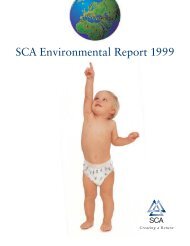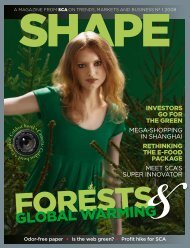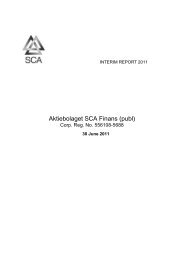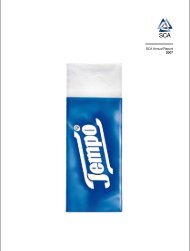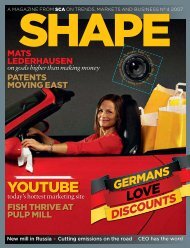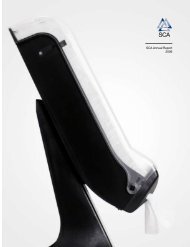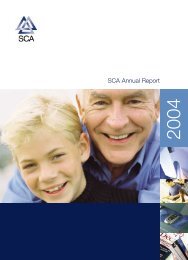Annual Report 1998
Annual Report 1998
Annual Report 1998
Create successful ePaper yourself
Turn your PDF publications into a flip-book with our unique Google optimized e-Paper software.
32<br />
Research and development<br />
CUSTOMER-ORIENTED RESEARCH<br />
SCA continually develops new products to meet customers’ demands. The company’s development work also<br />
focuses on reducing production costs and minimizing environmental impact.<br />
SCA’s research concentrates on creating added value by offering<br />
the customer a better product, increasing recovery of<br />
materials and energy in production, and increasing the proportion<br />
of recyclable material in SCA’s products. This focus is a logical<br />
consequence of SCA’s business concept, which focuses on<br />
long-term favorable profitability and a closed-loop philosophy.<br />
To maintain a high degree of recycling, natural by-products<br />
of pulp manufacturing are collected and incinerated, which in<br />
turn generates energy that is redirected back into production.<br />
Moreover, production processes are continually adjusted to increase<br />
the proportion of renewable resources such as recycled<br />
paper.<br />
SCA’s research is customer-oriented. Through market research<br />
and direct contact with customers, SCA develops new<br />
improved products that increase the company’s competitiveness.<br />
This work is often conducted by project groups working<br />
close to the customer to identity preferences and requirements<br />
or communicate SCA’s own improvement suggestions. The<br />
ideas are then evaluated in a technical and commercial perspective<br />
to assess their feasibility.<br />
These aims and procedures depend on efficient, marketoriented<br />
research. For this reason, the organization is projectoriented<br />
and based on delegation, assigning responsibility to<br />
carry out development work to all Group functions. The operations<br />
are spread over four research centers: Sundsvall and<br />
Diapers are often constructed using so-called super-absorbents<br />
to increase their absorption capacity. In sanitary pads, however,<br />
the possibilities for using these substances are limited.<br />
The development project began when it was discovered that<br />
a type of pulp manufactured at the Östrand pulp plant in<br />
Sweden could absorb blood unusually well. Consequently, in<br />
1993, Östrand – a unit of SCA Graphic Paper – and SCA<br />
Hygiene Products launched a joint project to develop a new<br />
absorbent material based on paper pulp.<br />
Two years of intensive effort, where the material was developed<br />
further to meet all absorption, comfort and softness<br />
Gothenburg in Sweden, Aylesford in southern England and<br />
Mannheim in Germany. SCA employs about 700 persons in research<br />
and development operations.<br />
SCA’s research and development operations in Sundsvall<br />
will be reinforced substantially by the planned new university<br />
for research in the forest industry, to which SCA will relocate<br />
its research center. This will create close links between primary<br />
research, applied research, product development and production.<br />
New products<br />
SCA maintains a high level of innovation to continually<br />
strengthen the company’s competitiveness. On average, SCA<br />
applies for 60 to 80 patents a year for a new product or production<br />
process – that is, more than one patent application a<br />
week. Apart from such applications, SCA launches several<br />
product innovations. In the pulp and paper field it is more<br />
common that new production techniques are developed which<br />
provide for improved products or lower production costs. A<br />
good example of this is the new low-energy TMP technology.<br />
Number of patent applications<br />
1994 1995 1996 1997 <strong>1998</strong><br />
85 67 66 75 77<br />
The new Efficapt sanitary pad – a joint project of SCA business areas<br />
standards, as well as environmental requirements, etc., placed<br />
on sanitary pads, resulted in a prototype of the Libresse Invisible<br />
pad with Efficapt, as the unique new absorbent material<br />
was called. The new product was based entirely on renewable<br />
raw materials. The key in the development process was to<br />
find just the right fiber distribution that would cause fluids to<br />
be properly distributed in the pad.<br />
Following a final phase of investments in new machinery<br />
for serial production of the sanitary pad, the new product was<br />
ready to be launched in spring 1997.




